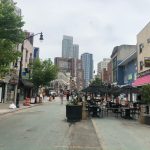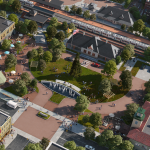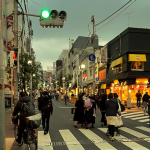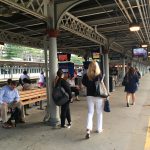New Jersey Future Blog
Hoboken’s Focus on Vision Zero Makes Streets Safe for Everyone
May 6th, 2021 by Tim Evans
The transportation-focused website Streetsblog recently turned a spotlight on Hoboken, praising the New Jersey city for its success in eliminating pedestrian deaths. The blog says that Hoboken “shows what can be accomplished when a municipality really focuses on the zero of Vision Zero.” The term “Vision Zero” generally refers to the goal of reducing pedestrian fatalities to zero. In most places with such plans, the goal remains aspirational, but Hoboken has made it a reality.
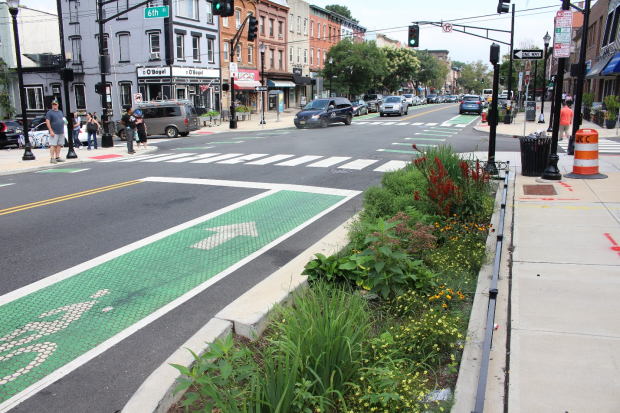
Washington Street, Hoboken, New Jersey
Designed for People Before Cars
Hoboken benefits from several advantages, compared to other parts of the state and the country. Like most urban centers and first-generation “streetcar” suburbs in the Northeast and Midwest, Hoboken experienced its initial growth spurt in the decades before the automobile became the default mode of transportation in the U.S. Despite its population rebound over the last three decades, Hoboken still has fewer residents today (52,677 as of the Census Bureau’s 2019 municipal population estimates) than it did in 1930 (59,261). Hoboken is inherently pedestrian-oriented, because it was built during an era in which everyone was essentially a pedestrian, either walking around town or walking to and from public transportation.
Even within New Jersey, Hoboken’s street network is more grid-like and finer-grained than those of most other cities. Its median block size of 2.83 acres is small enough to rank Hoboken number 42 among the state’s 565 municipalities, with respect to block size (the median municipality has a median block size of 5.18 acres). Small blocks with frequent intersections create multiple routes for pedestrians, cyclists, and car drivers, as opposed to branching networks, which inhibit direct routes and force people into their vehicles and onto regional arterial roads. Additionally, the short distances between intersections that are characteristic of street grids tend to limit vehicle speeds, enhancing pedestrian safety.
Conversely, rapidly-growing metropolitan areas in the Sunbelt have developed with the automobile at the core of their urban fabrics. Their streets were designed with the primary goal of moving cars rapidly across town, treating pedestrians as an afterthought at best. Data corroborate this trend; the metropolitan areas with the highest pedestrian death rates, according to Smart Growth America’s Dangerous By Design 2021 report, are predominantly located in the Sunbelt.
Pursuing the Vision with Action
Still, Hoboken didn’t accomplish zero traffic deaths solely because of its pre-World War II development pattern. Its laudable achievement is the result of a deliberate and sustained effort, the centerpiece of which is the redesign of a 16-block stretch of Washington Street, the city’s main commercial thoroughfare. While Washington Street serves local shopping needs, the presence of Hoboken Terminal (one of the state’s busiest rail transit stations) at the corridor’s southern end generates additional pedestrian traffic by attracting visitors and commuters to and from elsewhere in the New York metropolitan area.
New Jersey Future awarded the project a Smart Growth Award in 2020 for capitalizing on the city’s well-connected street grid by adding design features that seek to improve the pedestrian experience. These tactics are replicable in any mixed-use downtown, so numerous New Jersey towns can learn from Hoboken’s achievements. Hoboken’s enhancements to pedestrian safety include:
- Curbside rain gardens, which capture stormwater, aesthetically improve the streetscape, and create buffers between pedestrians and moving traffic
- Curb extensions, which reduce the width of intersections, limit the speed of turning vehicles, and shorten crosswalks (consequently reducing the amount of time that pedestrians need to cross the street).
- Traffic signal improvements, including the incorporation of pedestrian-only phases and the addition of pedestrian countdown timers, which allow pedestrians to cross streets more safely.
- Efforts to increase the visibility of bus stops in order to alert drivers to the presence of people boarding or exiting buses
- Striping new bike lanes, which makes drivers more aware of the presence of cyclists and encourages cycling.
- Designating loading zones for trucks and other delivery vehicles, which reduces the frequency with which these vehicles double-park. This alleviates a major safety hazard for pedestrians, cyclists, and drivers, and the rise of online shopping will likely make parking for delivery vehicles an even bigger issue in the future.
Benefits of Walkability
Getting people out of their cars for local trips produces numerous societal benefits: less air pollution, less time wasted behind the wheel, and regular exercise that can help ward off the many health problems that are symptomatic of a sedentary lifestyle. For older or disabled community members who cannot drive, living in a walkable town means that the loss of a driver’s license does not have to result in the loss of quality of life. And, of course, reducing car travel also helps reduce greenhouse gas emissions, an important climate-change mitigation measure.
Fortunately, there is strong demand for in-town living and a “car-light”–or even car-free–lifestyle. Furthermore, New Jersey contains many centers with the “good bones” of well-connected street grids. But, to translate these assets into substantive behavioral changes, people must feel safe when walking. Hoboken should serve as a statewide–as well as national–model for how to turn Vision Zero into a reality.
Related Posts
Tags: hoboken, pedestrians, traffic, walkability, Washington Street


